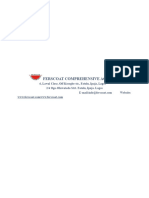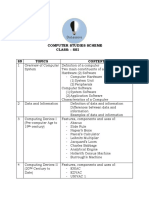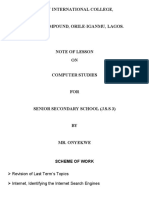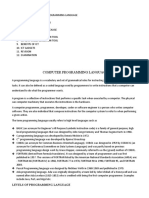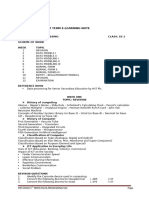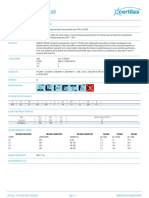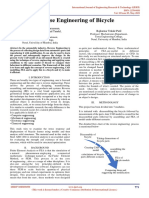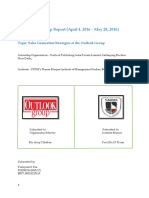0 ratings0% found this document useful (0 votes)
460 viewsSs1 Data Processing Lesson Note For Week Five
The document provides information about a data processing lesson for students aged 13 in classes of silver, bronze, copper and platinum. It discusses the topics of information processing, procedures for information processing including collation, organization, analysis and interpretation of information. Specifically, it defines information processing as the conversion of latent information to manifest information through equivocation, dissipation and transformation. It also outlines the stages of information processing as collation, organization, analysis and interpretation.
Uploaded by
Chrome AdminCopyright
© © All Rights Reserved
Available Formats
Download as PDF, TXT or read online on Scribd
0 ratings0% found this document useful (0 votes)
460 viewsSs1 Data Processing Lesson Note For Week Five
The document provides information about a data processing lesson for students aged 13 in classes of silver, bronze, copper and platinum. It discusses the topics of information processing, procedures for information processing including collation, organization, analysis and interpretation of information. Specifically, it defines information processing as the conversion of latent information to manifest information through equivocation, dissipation and transformation. It also outlines the stages of information processing as collation, organization, analysis and interpretation.
Uploaded by
Chrome AdminCopyright
© © All Rights Reserved
Available Formats
Download as PDF, TXT or read online on Scribd
You are on page 1/ 2
LESSON NOTE FOR WEEK FIVE (14/02/2022-18/02/2022)
SUBJECT: DATA PROCESSING
CLSASS: SSI (SILVER, BRONZE, COPPER AND PLATINUM)
AVREAGE AGE: 13 YEARS.
DURATION: 40 MINUTES PER PERIOD
TOPIC: INFORMATION PROCESSING
Information processing
Information processing is the process of changing information from one form to another detectable
by an observer. In computer, an information processor changes the form of the presentation of a
text file. Information processing can be specifically defined as the conversion of latent (hidden)
information into manifest information. Latent and manifest information is defined through the
following terms 1. Equivocation (what value the sender has actually chosen) 2. Dissipation (what
the receiver has actually received) and 3. Transformation (the changes that takes place).
Information processing can be sequential or parallel, either of which may be centralized
distributed.
Procedures for information processing
Information processing procedures is defined as the sequence of events in information
transformation. It is also known as information processing cycle. Information in the computer exist
in two states (binary) known as digital information. It worth to note that modern information is
characterized by extensive change from analog and digital form.
The following are the stages/ procedures for information processing.
1. Collation of information
2. Organization of information
3. Analysis of information
4. Interpretation of information.
Collation of information
Collation is the assembly of written information in to standard order. One type of information
collation is called alphabetization; thought collation is not limited to letter ordering by alphabet,
listing of words or names into alphabetical order is the basis of the most office filing systems,
library catalogs and reference books. Collation is difference from classification in that
classification is concerned with arranging information into logical categories while collation is
concerned with the ordering of those categories.
Organization of information
Organization of information is the process of arranging information using a particular pattern. In
any collection, physical objects are related by order. The ordering may be random or according to
some characteristic called a key. some characteristics may be intrinsic property of an object such
as weight, size, shape and color or they may assigned from some agreed-upon set such as object
class or date of purchase. In most cases, orders are imposed on a set of information objects for two
reasons: to create their inventory and to facilitate locating specific object in the set.
Ways of organizing information
1. Alphabetical
2. Chronologically
3. Statistically
4. Subject
5. Geographical
Analysis of information
Information analysis is the science of evaluating information content, and refining information to
build facts. It involves breaking of complex information into piece in order to under study it.
Information analysis works both for managers who use a non-quantitative process and for those
who use a quantitative invest process. It is used to determine whether the available information
can add value to investment process.
Interpretation of information
During the interpretation stage, researchers assess the usefulness of their information and reflect
to develop personal meaning. Information requires interpretation to become knowledge. The
interpretation stage engages researcher in the process of analyzing, synthesizing and evaluating
information to determine its relevancy and usefulness to their research question or information
need. These stages of information processing require students to be trained on a critical thinking
skill.
You might also like
- Scheme of Work Ss2 First Term: Week Topic Central Processing Unit (CPU)No ratings yetScheme of Work Ss2 First Term: Week Topic Central Processing Unit (CPU)13 pages
- SS1 Data Processing Lesson Note Second TermNo ratings yetSS1 Data Processing Lesson Note Second Term16 pages
- SS2 Data Processing Lesson Note Second TermNo ratings yetSS2 Data Processing Lesson Note Second Term20 pages
- SSS 2 ICT (Second TERM - FINAL EXAM) 2022-2023No ratings yetSSS 2 ICT (Second TERM - FINAL EXAM) 2022-20234 pages
- Computer Studies JSS 3 3RD Term EdittedNo ratings yetComputer Studies JSS 3 3RD Term Editted28 pages
- Lesson Note - JSS 1 - Second - Easter Term100% (1)Lesson Note - JSS 1 - Second - Easter Term84 pages
- Ss 2 Data Processing Second Term E-NoteNo ratings yetSs 2 Data Processing Second Term E-Note40 pages
- SS3 Data Processing Lesson Note Second TermNo ratings yetSS3 Data Processing Lesson Note Second Term9 pages
- Computer Studies Scheme Class: - Ss1: SN Topics ContentNo ratings yetComputer Studies Scheme Class: - Ss1: SN Topics Content7 pages
- Penny International College, Coker Compound, Orile-Iganmu, LagosNo ratings yetPenny International College, Coker Compound, Orile-Iganmu, Lagos7 pages
- 2nd Term SS2 - Data Processing Note 2022 - 2023No ratings yet2nd Term SS2 - Data Processing Note 2022 - 202360 pages
- Classification of Means of Transmitting Information - ClassNotes - NGNo ratings yetClassification of Means of Transmitting Information - ClassNotes - NG7 pages
- Jesuit Memorial College, Mbodo Aluu Lesson Note PlanNo ratings yetJesuit Memorial College, Mbodo Aluu Lesson Note Plan4 pages
- Data Processing SS 1 Exam First Term 2021No ratings yetData Processing SS 1 Exam First Term 20213 pages
- 1st Term Data Processing Mid Term Test 2019100% (1)1st Term Data Processing Mid Term Test 201911 pages
- 2nd TERM EXAM ESTBANK ACADEMY DATA PROCNo ratings yet2nd TERM EXAM ESTBANK ACADEMY DATA PROC12 pages
- Computer Engineering Department: Micro Project ReportNo ratings yetComputer Engineering Department: Micro Project Report18 pages
- 2021-BIM PROPOSAL - ALVEO-CERCA PH 3 B+T1 - Docusigned100% (1)2021-BIM PROPOSAL - ALVEO-CERCA PH 3 B+T1 - Docusigned4 pages
- Steel Construction Manual: Companion To The AiscNo ratings yetSteel Construction Manual: Companion To The Aisc280 pages
- List of Deleted Topics of Maths TextbookNo ratings yetList of Deleted Topics of Maths Textbook3 pages
- Bossard - Whitepaper - Fastening Solutions For Composite and Plastic Materials - EN - 04-2021No ratings yetBossard - Whitepaper - Fastening Solutions For Composite and Plastic Materials - EN - 04-202127 pages
- 2020 Hitachi Electric Chain Hoist - Product SheetNo ratings yet2020 Hitachi Electric Chain Hoist - Product Sheet5 pages
- The Basics of Python For Loops A Tutorial - Learn Data Science With DataquestNo ratings yetThe Basics of Python For Loops A Tutorial - Learn Data Science With Dataquest1 page
- Candidate Evaluation Details: Hidayath Ali MokulaNo ratings yetCandidate Evaluation Details: Hidayath Ali Mokula2 pages
- Reverse Engineering of Bicycle IJERTV10IS050350No ratings yetReverse Engineering of Bicycle IJERTV10IS0503509 pages
- Physiology Marrow Ed8 [Medicalstudyzone.com]No ratings yetPhysiology Marrow Ed8 [Medicalstudyzone.com]267 pages
- Summer Internship at Outlook Magazine IndiaNo ratings yetSummer Internship at Outlook Magazine India34 pages
- Product Recommendation TCM Forklift & Reach Trucks, Petrol FG25N2 Nissan H20 (1988-1991)No ratings yetProduct Recommendation TCM Forklift & Reach Trucks, Petrol FG25N2 Nissan H20 (1988-1991)3 pages













